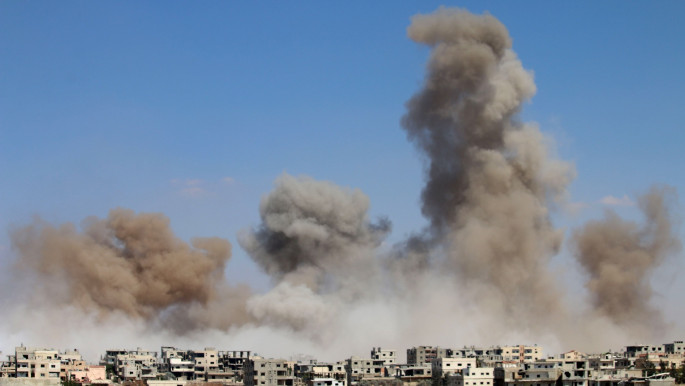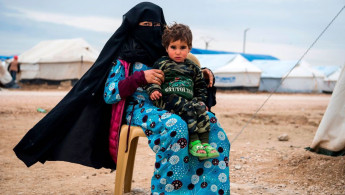'Raising a family with nothing': War takes its toll on Syria's displaced women
A total of 5.5 million people fled abroad, while the poorest echelon of Syrian society was forced to seek refuge in humanitarian camps.
These civilians became internally displaced persons - or IDPs - who remained in the same country but lost everything that resembled home. More than 870,000 people find themselves in what are known as 'last resort camps', living in make-shift IDP settlements that were meant to be temporary.
On the border with Iraq lies Al-Hol camp, the largest of its kind in the northeast of the country - built for 10,000 people but now hosting 62,000.
About 80% of its residents are women and children. Most of them are Syrians or Iraqis displaced by the Kurdish-led battle against the Islamic State (IS) which captured the group's last scrap of territory in March 2019.
Widowed by a decade-long war that has taken the lives of an estimated 586,000 people, Syrian women face a myriad of social, economic, and healthcare challenges that leave them at particular risk. In what are very conservative areas of the country, the loss of your husband can mean no access to basic services, so many are left to raise their families in camps plagued by dire conditions.
"There is no way out for them unless they have other family members who are supportive. Raising a family in this context is underestimated and undercovered," says Diana Rayes, a Syrian American health researcher working with the Syria Public Health Network.
During her work with IDPs in Syria, Rayes noticed the lack of essential services provided to women in these camps. "Mental health needs are great among women, and I think the psycho-social stressors that are experienced by them are really underestimated and underreported," Rayes told The New Arab.
 |
Syrian women face a myriad of social, economic, and healthcare challenges that leave them at particular risk |  |
"Many become pregnant - whether they're planning for it or not - and need access to reproductive healthcare, and that's something that is a huge shortage in IDP settings."
The living conditions within the camp have been decried as uninhabitable by the World Health Organisation, and its residents face increasing danger every day; bouts of gang violence, child labour, lack of healthcare structures, poor sanitation, and little to no employment are commonplace in the camp.
The aid these residents receive is also linked to the past; their alleged former ties with IS do not go unpunished.
"There are humanitarian organisations and donors that are not willing to provide services to certain areas of the camp due to people's perceived affiliations," says Will Turner, MSF Emergency Manager for Syria, who believes healthcare should be provided regardless of "status and origin of displacement."
Al-Hol, like many IDP camps throughout Syria, is managed by local authorities, in this case the US-backed Kurdish group known as Syrian Democratic Forces.
Twitter Post
|
"Now, IDPs are completely under the grip of these groups; they control their lives, their food, their health, and all the services you can imagine," says Noha Alkamcha, a Syrian expert on humanitarian aid and civil society in Syria.
This iron-fisted control affects the access aid workers have to women living in camps, and Alkamcha personally experienced a backlash from local authorities when working around women's rights in IDP camps. "I was kicked out of the camp and told 'you're not welcome here, we don't know what your agenda is or who the people you are aiding'. This was someone sent by an armed group, so I had to leave and could never go back."
The authorities' hostility to women's issues also reproduces a system of control that suppresses their freedoms in a systematic manner.
"This is a huge challenge for civil society organisations and humanitarian organisations because there are customs and traditions that are often intended by patriarchal practices in the community to limit women's freedoms and their implementation of independent activities that could empower women," Alkamcha told The New Arab.
This environment has created conditions that may be dangerous to the security of women in the camp, whereby "stigma and cultural norms prevent women from speaking about gender-based violence (GBV) that they may be experiencing," says Rayes.
But shortfalls in the management of these camps do not just lie in the hands of de-facto authorities. Alkamcha believes the way in which international humanitarian organisations allocate aid may also be detrimental to the residents of IDP camps.
"A lot of development agencies poured money into humanitarian projects which led to a lot of local communities and IDPs to rely on food baskets instead of creating projects that could assist them in wanting to work and rebuild a society," she says.
"They are just shoving people into camps and then giving them food baskets, hygiene kits, winterisation kits. The impact of this will be immense; there will a lot of work and money needed to get IPDs out of camps and normalise them back to a life they had before the war."
 |
Humanitarian organisations often fail to include local groups from being part of the decision-making process, which could be vital to empowering IDPs and local women's groups |  |
Humanitarian organisations also fail to include local groups from being part of the decision-making process, which Alkamcha believes is vital to empower IDPs and local women's groups. She cites the exclusion of women-led groups in northwest Syria, who work with local authorities and would be able to provide more localised guidance on how international organisations should work in the region.
The empowerment of local groups could also help gain access to women's spaces that may not otherwise be welcoming to foreign or male aid workers, and for IDP women who are especially vulnerable, this is vital for their wellbeing.
"It starts with talking to women in these contexts and asking them about what they've experienced both physically and mentally in terms of GBV, and using words that they use themselves to define this issue and then discovering ways in which to intervene and to support them," says Rayes, which is why she is happy to see so many women involved in aiding their community.
 |
|
| The cradle of Syria's revolution: Daraa ten years on |
"A lot of women left their careers prior to the war to join the health workforce as midwives, nurses, and doctors to serve the population. I think this is key in this conservative society because women can gain the trust of IDP women who need support rather than men working in the humanitarian context."
The 10-year anniversary of the Arab Spring may not be a cause for celebration for many Syrians still paying the price for their revolution against Assad's dictatorship, but a small victory can be attributed to the growing awareness surrounding the need to advance women's rights in Syria, which has much improved since 2011.
"What happened in 2011 was not just to challenge Assad, but also the cultural norms and traditions. Women took to the streets like men did despite the risk of their families or communities' rejection and that was one of the good things that happened because of the Syrian uprising," says Alkamcha.
"The good side of the conflict is that women in rural parts of Syria, outside Idlib and Aleppo, have been able to form organisations and initiatives they would never have been able to do prior to 2011. They challenged the patriarchal system that dominates society enshrined by the religiously strict authorities which have always been a challenge to any human rights work for women."
Studies show that women in IDP camps are slowly joining the workforce to become the "breadwinners" of their families, but 2020 statistics obtained by the NGO World Vision found only 13% of women surveyed had managed to become the main providers in their families.
As the campaign for women's rights grows in Syria, the women most vulnerable - regardless of their history - need to be included in the conversation about how they can move forward; past the war and past the IDP camp.
Gaia Caramazza is a staff journalist at The New Arab. Follow her on Twitter @GaiaCaramazza




 Follow the Middle East's top stories in English at The New Arab on Google News
Follow the Middle East's top stories in English at The New Arab on Google News


